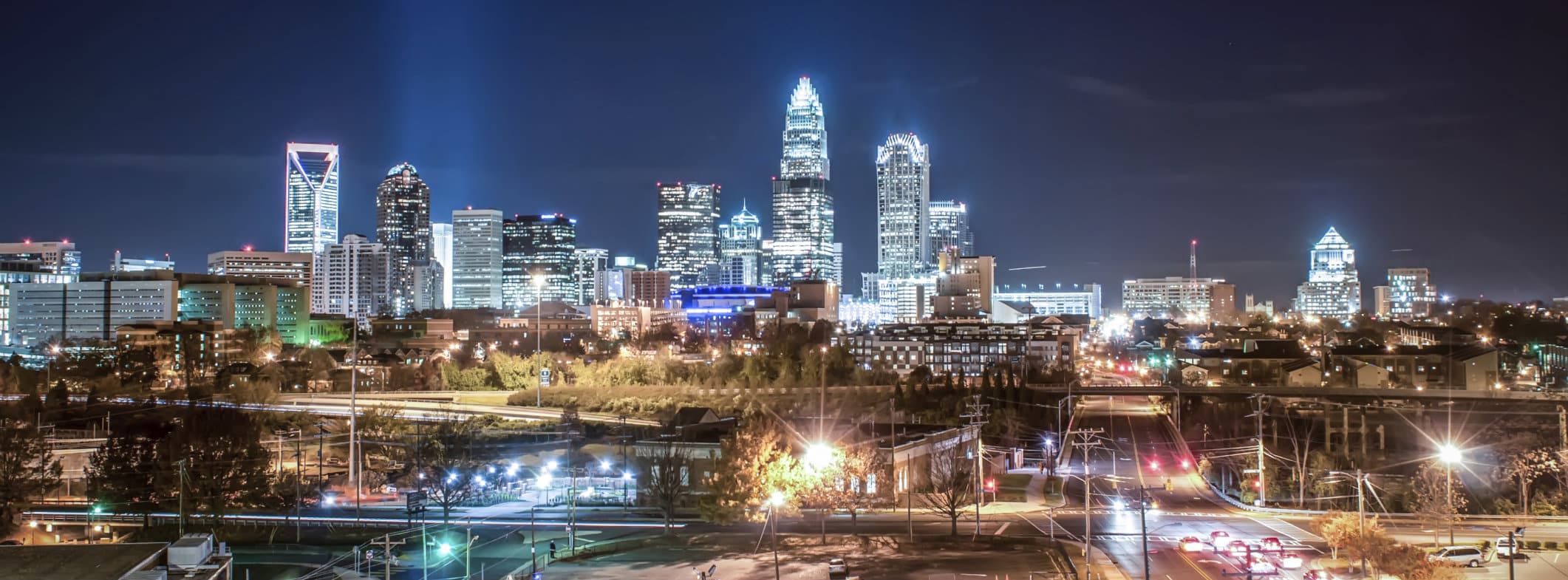
Charlotte’s Popular Urban Neighborhoods
Nestled between Uptown’s high-rises and Charlotte’s southside suburbs are what many consider the jewels of the Queen City’s residential crown – its original streetcar suburbs. As you travel the broad, tree-lined, leaf-canopied streets, you’ll see the Charlotte of the turn of the last century and pre-World War II. If you’re interested in exploring homes for sale in one of Charlotte’s urban neighborhoods, learn more below!
Dilworth
History of Dilworth
Start in the oldest suburb, Dilworth. The vision of Edward Dilworth Latta, this neighborhood was developed in the 1890s thanks to the advent of the streetcar and was the first place for Charlotteans to live outside the city.
Homes in Dilworth
The streets of Dilworth feature houses wrapped with front porches. The homes are primarily bungalows with the occasional Queen Anne thrown in and some larger, two-story Colonial Revival homes that line Dilworth Road East and West.
The road is lined with restaurants, offices and shops, many located in renovated homes. New developments like Latta Pavilion, named after Dilworth’s original entertainment center, offer condominiums, office and retail space, and landscaped courtyards and walkways.
What You’ll Find in Dilworth
You also will find Holy Trinity Greek Orthodox Cathedral, which draws thousands to its annual Yiasou Greek Festival in September. At the other end of the boulevard is the entrance to Freedom Park, well known for its annual arts festival, athletic fields, walking paths and amphitheater.
Charlotte’s largest hospital, Carolinas Medical Center, has its flagship facility in Dilworth. This 861-bed teaching hospital is the region’s only Level 1 trauma center and is also home to the Levine Children’s Hospital, another branch of the Carolinas HealthCare System.
South End
History of South End
South End, one of Charlotte’s hottest communities, is on Dilworth’s western edge. Whether it was the result of the cotton industry, Pepsi-Cola, Lance Packaging or a variety of other innovators and artists, the construction of warehouses was a common architectural theme throughout South End starting in the late 1800’s. Just 20 years ago, the area was an eyesore of run-down mills, but through a rehabilitation project supported by Charlotte voters, South End is now home to a variety of single-family homes, condominiums, apartments, restaurants, local businesses and more!
Homes in South End
Today, the mills have been renovated into shops, restaurants and apartments and condominiums next to Uptown, making it a trendy locale for many, including those living on their own for the first time in Charlotte. While the rebirth initially generated commercial development, new residential options have cropped up, including Summit Grandview and The Arlington, a 25-story condominium high-rise with a pink hue that’s hard to miss.
What You’ll Find in South End
In addition to a plethora of shops, restaurants, bars and fitness boutiques, South End is a vibrant neighborhood for people of all ages. It’s also home to the Charlotte Trolley and is the site of several of the LYNX light rail stops. Residential and commercial development has boomed near the tracks, and property values along the route have skyrocketed.
Myers Park
History of Myers Park
If you want your neighborhood to be more traditional than trendy, Myers Park may be right for you, if you can handle the price tag. Myers Park was developed in the early 1900s by a real estate tycoon who wanted to create a neighborhood in the country. Today his countryside is a mere five minutes from Uptown, but you can’t help but feel miles away as you travel the curving boulevards and lanes with their towering willow oaks that dwarf even the grandest Myers Park homes.
Homes in Myers Park
While most of the Myers Park homes are older, traditional houses, a few infill projects offer new options. These projects, primarily townhouses and condominiums, come at a hefty price due to skyrocketing land values. In fact, Myers Park features two of only a handful of developments with units exceeding $1 million. Among them is 2400 Roswell, with 21 luxury condos, and nearby St. Serrant, offering two balconies for each of its 11 units. Both developments provide lavish decor and amenities to appeal to the most prestigious tenants.
What You’ll Find in Myers Park
Myers Park is home to the prestigious Queens University, on Selwyn Avenue. This liberal arts school was founded in 1857 and moved to its Myers Park campus in 1914. In addition to undergraduate studies, the university offers several graduate degrees, courses for working professionals and continuing education classes. It’s perfect for those who want to continue their education while living in Charlotte.
The shops and restaurants along Providence Road on Myers Park’s eastern edge, including Laurel Market, the shops in the Villa and the old Manor Theater (rumored to be haunted!) are neighborhood favorites.
View AreaEastover
History of Eastover
Eastover, tucked between Providence and Randolph roads, was developed after Myers Park and features majestic homes on broad, rolling lawns.
Homes in Eastover
Some of the original homes in Eastover have been replaced by even more grandiose homes or infill projects for the truly discriminating buyer. The Crillon, an upscale development of 11 luxurious townhomes in the heart of Eastover, features units priced over $1 million.
What You’ll Find in Eastover
Eastover is also home to the Mint Museum of Art, which garnered its name from the building, which housed Charlotte’s original mint, which was moved from Uptown to this site in 1936. The Mint specializes in art of the Americas, from pre-Columbian to present day, and features many national exhibits.
View AreaElizabeth
History of Elizabeth
Named after Anne Elizabeth Watts, whose husband, Gerard Snowden Watts, was in the tobacco business in Durham, the neighborhood of Elizabeth became a part of Charlotte in 1907.
Homes in Elizabeth
Across Randolph Road, from Eastover, is the charming community of Elizabeth, a pedestrian-friendly neighborhood where residents can walk to a variety of locally-owned restaurants. The homes, located off Randolph Road and Seventh Street, are bungalows, but feature a greater architectural variety than those of Dilworth. Consequently, the neighborhood’s popularity means even the smallest homes fetch a hefty per-square-foot price.
What You’ll Find in Elizabeth
The main campus of Central Piedmont Community College is located on the edge of Elizabeth. CPCC is the largest community college in the state and has satellite campuses across the region. You’ll also find that a variety of restaurants and shops are all within walking distance along the trolley tracks.
A short walk from the campus is Thompson Park, home to Mecklenburg’s Vietnam Veterans Memorial. The quaint St. Mary’s Chapel, also in the park, is owned by the city, but available to anyone to rent for weddings. It’s hard to imagine three hospitals on one block, but that’s exactly what you find at the intersection of Randolph Road and Caswell Avenue. Presbyterian Hospital, Presbyterian Orthopedic Hospital and CMC-Mercy Hospital are a stone’s throw from one another. Numerous medical offices are also nearby.
View AreaChantilly
History of Chantilly
Located within the beautiful and booming city of Charlotte is the Chantilly neighborhood. This community is located between Elizabeth and Plaza-Midwood. Established in 1913, many homes were constructed during the 1940s, and still have the older home character today. Additional streets were added to this neighborhood in the 1950s.
Homes in Chantilly
Chantilly features beautiful streets and charming bungalows. It’s not yet as pricey as Elizabeth, though it’s well on its way. Many homes in Chantilly are bungalow or craftsman-style homes that have recently been updated. You’ll also find many homes with wood floors, 2-car garages and fireplaces in Chantilly.
What You’ll Find in Chantilly
Chantilly is known for its art galleries, restaurants, and unique stores. In addition, residents here enjoy the seven-acre Chantilly Park. Chantilly parks are also utilized year-round and are home to many events hosted by the Chantilly Neighborhood Association, such as the Spring Fling or the Halloween Parade and pizza party.
View AreaPlaza-Midwood
History of Plaza-Midwood
From Chantilly, you come to Plaza-Midwood, a neighborhood comprising several smaller subdivisions. Plaza-Midwood traces its development back to 1903, when the first roads and trolley lines were laid among the trees. The community is bordered by Central Avenue and The Plaza.
Homes in Plaza-Midwood
The Plaza is a residential boulevard lined with stately old homes, including the historic Van Landingham Estate, a bed and breakfast that is available to rent for special events. The wide variety of homes in Plaza-Midwood may be the draw behind its diverse population. This is one of the few historic neighborhoods nearing Uptown where you will still find charming, affordable homes among larger, expensive homes. As with other historic neighborhoods, Plaza-Midwood is seeing its share of infill projects where the price per-square-foot is relatively high.
What You’ll Find in Plaza-Midwood
Central Avenue has enjoyed a great deal of redevelopment lately that complements its antique shops and vintage clothing stores, while new restaurants and entertainment venues have made it a hot destination. Charlotte Country Club, the city’s oldest country club, is surrounded by grand homes dating back to 1920. The Country Club’s quiet, curving streets blend seamlessly with those of Plaza-Midwood, making the two communities seem singular.
View AreaNoDa
History of NoDa
Home to a variety of mills and industrial architecture in the early 1900’s, like many Charlotte neighborhoods, the latest urban neighborhood to see a rebirth is Historic North Davidson, or NoDa. The community in NoDa is known for its funky art galleries and colorful bungalows.
Homes in NoDa
In addition to old shotgun homes, NoDa has seen a boom in residential construction in the past few years. The Renaissance offers 230 affordable townhomes with a variety of floor plan options and the 100-year-old Highland Park Mill No. 3 at 33rd and North Davidson has been renovated into urban apartments and condominiums. There are a variety of single-family homes in NoDa, however as the desire for the neighborhood increases, so will the price tag on houses for sale.
What You’ll Find in NoDa
In addition to a variety of local restaurants and breweries, NoDa is also home to the NoDa Farmer’s Market and the NoDa Eclectic Marketplace – a pop-up shop that only opens on Saturdays, but truly embodies the “Art & Community first” mindset as it features artists, farmers, craftsmen, artisans, collectors and performers.
View Area








